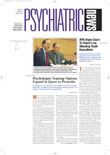At a meeting marking the fifth anniversary of the
Olmstead decision by the U.S. Supreme Court, participants reported limited progress in implementation (see
box below).
The meeting, titled “The Olmstead Decision Five Years Later: How Has It Affected Health Services and the Civil Rights of Individuals With Disabilities?,” was hosted in late June by the Alliance for Health Reform and the Kaiser Commission on Medicaid and the Uninsured.
Five years earlier, on June 22, 1999, the U.S. Supreme Court ruled in Olmstead v. L.C. that states are required to place persons with mental disabilities in community settings when the treatment professionals deem that setting appropriate, the individual does not object, and the placement can be “reasonably accommodated” (Psychiatric News, July 16, 1999).
Michael Gottesman, who argued the plaintiff's case and is now a professor of law at Georgetown University, told the audience that the “relatively easy” part of the decision was showing that discrimination had occurred when Georgia state officials required two women with mental disabilities to remain in a locked psychiatric ward even though they had been assessed as ready to live in community facilities.
The “hard part” was responding to the state's argument that the state “just can't afford to solve this problem.”
Gottesman said that the Supreme Court found a “middle ground” in responding to that question.
According to the decision, states can comply by demonstrating a“ comprehensive, effectively working plan for placing qualified persons with mental disabilities in less-restrictive settings and a waiting list that moved at a reasonable pace not controlled by the state's endeavors to keep its institutions fully populated” (see
box at right).
Tim Westmoreland, a visiting professor of law and a research professor of public policy at Georgetown University, was director of the federal Medicaid program from 1999 to 2001 and worked on the initial implementation of the decision. Medicaid is the major source of public funds for services for those with disabilities.
He commented that only about three-fifths of the states had made progress on their plans, adding, “Many of these plans... have vague targets, no timelines, and no connections to state budgets, which of course drive federal Medicaid spending. And, more important, only a few of the states. .have significantly improved their services in the last five years.”
Westmoreland also noted problems with relying on Medicaid as a source of funds for implementation of the Olmstead decision. When states have economic problems, as they have for the last three years, state officials cut Medicaid spending, which reduces the federal contribution.
Medicaid “favors institutionalization” in that the provision of nursing home benefits is mandatory, but home and community care benefits are not. In fact, their provision generally requires a waiver from the federal government.
He added, “[W]aivers are a bad thing for people with disabilities because they allow keeping eligible people out, forming waiting lists at the door. .and also allow very limited services to be provided [despite the fact that federal funds are used].”
States can use waivers to keep some people off the Medicaid rolls because a waiver allows them to stop providing a certain kind of optional service or to stop serving a group of people in exchange for providing different services or service to a different group of people. Since waivers are cost neutral, if beneficiaries or services are added, others must be cut.
Matt Salo, director of the Health and Human Services Committee of the National Governors Association, agreed that the Medicaid program is very much driven by “federal rules and regulations,” as well as by state budgets.
He claimed, however, that there had been an “enormous aggressiveness” on the part of the states to do as much as possible to serve people in their homes and communities.
States have obtained more than 220 individual waivers from the federal government to allow them to use Medicaid funds to provide home- and community-based care. Dollars spent on those services total about 32 percent of all spending on long-term care in the Medicaid program.
He added that given the popularity of the waivers, “these should not be waivers any more. We should be allowed to do this without bowing our heads to the federal government.”
Tom Perez, assistant professor of law at the University of Maryland, said that he had been hearing from those “in the field” that complaints were not being filed with the Office of Civil Rights about the slow pace of implementation because “there's a sense that there really is no enforcement.”
He added, “I don't think the states view the federal government as a credible threat at the moment, and that's one reason you see a lot of inertia out there in some quarters.”
“Olmsteadat Five: Assessing the Impact,” a report issued by the Kaiser Commission on Medicaid and the Uninsured, and numerous related reports are posted at<www.kff.org/medicaid/kcmu062104pkg.cfm.>.▪
